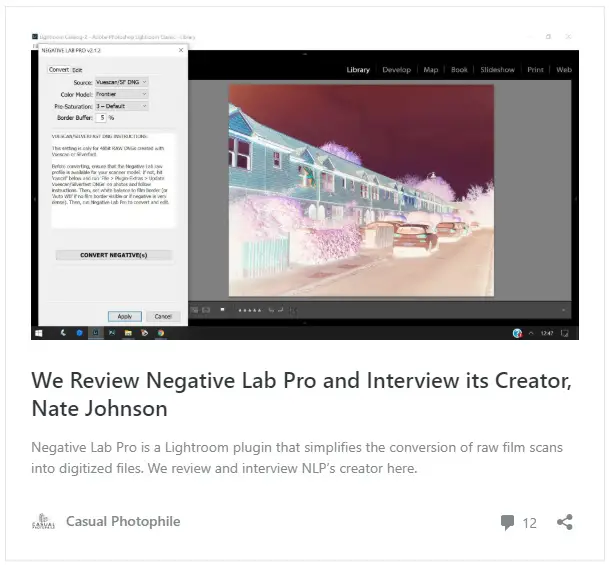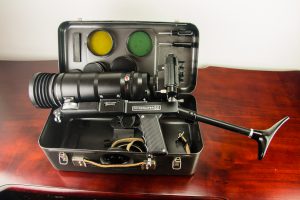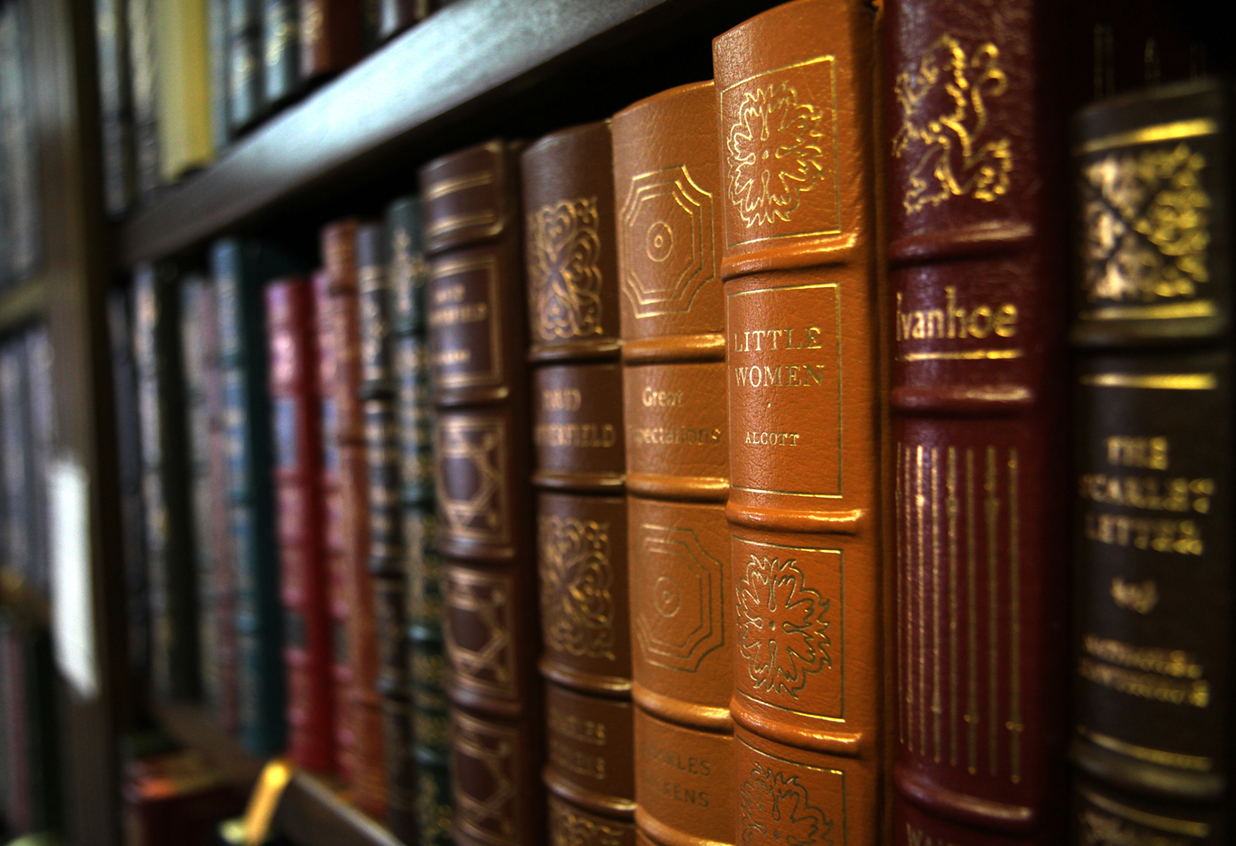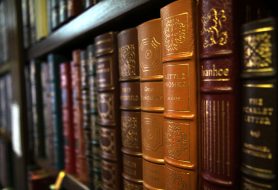 This week’s featured article is an interview with Nate Johnson, creator of a Lightroom plug-in called Negative Lab Pro. If you’ve ever scanned color film using a flatbed scanner and haven’t been pleased with the quality, perhaps you’ve tried digitizing the images yourself using a digital camera.
This week’s featured article is an interview with Nate Johnson, creator of a Lightroom plug-in called Negative Lab Pro. If you’ve ever scanned color film using a flatbed scanner and haven’t been pleased with the quality, perhaps you’ve tried digitizing the images yourself using a digital camera.
But if you’ve tried that, then you’re painfully aware at the difficulty of accurately transforming a color RAW file of a 35mm negative into a usable image. Reversing the negative image is only half the battle as you need to compensate for the brown base of the film, and constantly keep messing with curves, levels, tones, and pretty much every slider in Photoshop. I know all of this because I’ve tried it, and let me assure you, it is MADDENING!
Thankfully, Nate heard your cries and created this plugin which seems to do everything for you. James Tocchio has previously written about Negative Lab Pro and claimed it’s superiority to other options, but this week he has a chat with it’s creator, asking him how he came about creating this program and discussing what his vision for the future holds.
Digitizing is still uncharted territory for many of us, but after seeing promise from my early attempts, and combining that with the simplicity of this software, you may be seeing a Negative Lab Pro article on my site someday soon!
Here are more great posts from some of my favorite sites:
Last week I shared a Keppler’s Vault story about Kodak D-76 and somewhat fittingly, my friend Alex Luyckx gives us part five in his Developer Review Blog for Kodak D-23. This formula is just as old as D-76 but less stable and was a favorite of Ansel Adams. Kodak no longer makes prepared D-23 but you can create it at home with a formula that Alex includes in his article. If using off the shelf film developers is too easy for you, perhaps creating your own D-23 is right for you. Even if it isn’t, seeing a glimpse of processes from the days of yore is always interesting.
Continuing with another development article, this week Jim Grey from Down the Road gives us his thoughts on LegacyPro L110 black and white film developer. A copy of Kodak’s HC-110 which you can buy at places like Freestyle Photo and B&H, L110 is less expensive than the real thing, but is it as good? I read this article with a discerning eye as HC-110 is my favorite black and white developer. It has an incredibly long shelf life, it is very flexible working with fresh and expired films, and it helps to eliminate base fog on some older emulsions. As I read more about other developers, part of me wants to try something new, but then I see this and fall in love with -110 based developers again!
If all you ever shoot in your Rolleiflex is 120 roll film, then you’re missing out on a subset of what many Rolleis were capable of, 35mm. Unlike other TLRs in which you have to devise some sort of hack to make 35mm work, the makers of the Rolleiflex created a kit called the Rolleikin which does this for you. This week, Alyssa from Aly’s Vintage Camera Alley shares her thoughts (and a video) on the Rolleikin and what is possible shooting such a small film format on a camera designed for larger 6cm x 6cm images.
A couple of years back, I won an “AGFA Lot” of cameras from KEH that contained like 5 or 6 different Optima cameras and none worked correctly. I always had have a thought of trying to get them working, but after reading Peggy Marsh’s excellent review of the AGFA Optima III S rangefinder, maybe I should try and dig out that box! Peggy didn’t completely love the experience of using the camera, but sometimes, that’s what makes trying out old cameras, fun!

Once you’ve seen a Zenit Photosniper, you won’t forget it. Perhaps because it looks like a terrifying rifle. In reality though, its a purpose built Zenit SLR with a Tair-3 300mm f/5.6 telephoto lens mounted to a rifle-like stock that allows you to stabilize the camera for hand held shots with a very long lens. This article from Kosmo Foto by Iaian Compton takes a look at the whole Photosniper kit which came in a nice metal case with some filters, a strap, some hoods, and a standard 50mm lens for when you want to use the camera without the photo sniper attached. Most impressive about this article are the sample images that Compton managed to get, proving that while the whole setup might look scary, it is quite effective.
This week, my friend Eric from Aperture Preview gives us his look at the Balda Super Baldinette, a pre-war “Retina-esque” folding 35mm camera with a rangefinder and Heligon f/2 lens. One of the reason I like Eric’s reviews so much is that they’re much like mine, filled with a little bit of history, some technical information, how to, and his thoughts on the camera’s use. I have a similar Welta Weltini that has many of the same features as this camera and reading Eric’s review makes me want to dig that thing out and shoot it!
Although the majority of the articles on my site are film related, I do occasionally write about digital cameras as I like them too, but the thought of opening one up to modify one seems terrifying. Apparently Peggy Marsh from Camera Go Camera didn’t think so as she followed instructions she found online for opening up a Panasonic Lumix DMC FS-11 to convert it to take IR photos. I’ve never attempted to shoot IR film but I think the results look cool, and the thought of having a purpose built digital camera to do the same thing is even cooler! Peggy admits to not always succeeding when opening up electronics, but thankfully, this was one time where she was.
If your definition of “photography” requires only a digital or film camera, then you’re missing out on a wonderful subset of alternate process photography. 35mmc is doing a 2 part story called “Lockdown Lumen” in which 12 artists from around the world are “painting with light” using a wide variety of alternate processes. Developing images using things like beet juice or Polaroid lift processes are all creative ways to make interesting photographs outside of the norms that most people think of. This week’s article introduces us to the first six artists with six more to come next week.
I often hear from people who know I shoot old cameras that they’re amazed at how many can still easily be shot these days, but there is one style of camera that sadly doesn’t qualify as “easily shot” which is Polaroid’s pack film cameras. This week Alex Luyckx takes a look at one of Polaroid’s quality pack film cameras, the Automatic Land Camera Model 250, and shares some outstanding samples that he got with his. I actually have one of these in a box somewhere, but I missed the boat on pack film, so articles like this are my only glimpse into what these wonderful devices were capable of.
Andrew Smith from Kosmo Foto takes a look at the Canon Canonet QL-17, a compact, but very capable 35mm rangefinder that was made during Canon’s “last hurrah” of rangefinder production. It’s not the later G-III variant, of which I don’t know what’s different, but this well built camera with both an automatic and fully manual modes, and excellent 6-element f/1.7 lens is often championed as the perfect “all around film camera” as it’s small size and excellent performance make it a winner in most people’s eyes.
Aaah, the Olympus XA. Maitani’s last major design while working for Olympus and the world’s most compact, fully functional 35mm rangefinder camera. I’ve previously reviewed the XA2 and have a working XA somewhere around here, but this week Yarko Petriw from EMULSIVE gives us his thoughts on this compact wonder. Featuring an incredibly sharp and small 6-element F.Zuiko lens, I don’t think anyone would doubt that the XA is capable of great images. But did Olympus go too far, making the camera too small? After all, no other XA series cameras had a rangefinder. Read the article and find out!
In my last Recommended Reading, I shared a long review of the Nikon F100 by Stephen Dowling and perhaps by coincidence or inspiration, Casual Photophile has their own Nikon F100 article. Not quite a full review like Kosmo Foto’s article, this one by Craig Sinclair talks about the F100 and it’s digital equivalent the D700 and how the F100 changed how he approached digital. Many people, myself included, credit film photography with improving their digital photography as it slows you down and forces you to think, but if you’re still on the fence about how shooting film might do that for you, I recommend you check out this article.
Finally, just to prove that I don’t always include crazy music videos at the end of a Recommended Reading post, I found this really fascinating article on Extreme Tech about a computer from 1959 that is still in operation at Fujitsu in Japan. Called the FACOM128B, the computer uses mechanical relays instead of vacuum tubes like contemporary computers of the time would have used, and although that might have seen like a strange choice then, it proved to be a good decision as the FACOM128B still works today crunching addition and subtraction problems at a rate of 5-10 per second! If a relay breaks, it can be repaired, if a vacuum tube dies, it needs to be replaced and as the decades go on, finding working replacements gets harder and harder.
The article is about a single Fujitsu employee named Tadao Hamad whose job is to keep the computer running and why he does it. The article is very interesting, but leads to an even more interesting YouTube video that goes much more in depth to the history and operation of the FACOM128B.
I love this sort of stuff and in a way is a perfect inclusion here on a site dedicated to using old cameras. I must say though, that shooting a 1959 Nikon F or some other camera built at the same time as the FACOM128B is MUCH easier to do!


